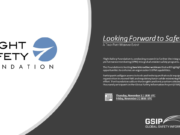
Why might U.K. law have an impact on the global aviation industry? The protection of safety information has been a key concern as the tendency toward litigation has increased over the years. Aviation safety in the United Kingdom took a significant step forward with two judgments handed down by the U.K.’s High Court1 in September 2016, and it is possible that the principles established by these judgments will be used to argue cases in other parts of the world.
The first case related to the tragic Hunter accident at the Shoreham air show in August 2015 in which 11 people lost their lives. As part of the separate police investigation into the accident, the chief constable of Sussex Police made an application to the High Court for disclosure of materials obtained during the U.K. Air Accidents Investigation Branch (AAIB) investigation; this was the first such application made in England and Wales since the relevant aircraft accident investigation regulations came into force in 1996. The application had the effect of asking the court to conduct a balancing exercise to determine whether the public interest in release of all the material requested as part of the police investigation was greater than the negative impact on future safety investigations.
The judges refused disclosure of all the requested material, excepting the camera footage from the cockpit, which had been intended for broadcast and could not, therefore, be considered as protected safety information. The legal argument set out in the judgment was founded on the International Civil Aviation Organization Annex 13 provisions, the relevant European Union (EU) regulations and the supporting U.K. laws on civil aviation and the investigation of accidents.2
The crucial part of the judgment concerned the requested release of witness statements, and the judge explained his reasoning as follows:
In my view, it is almost inconceivable that statements made to the AAIB could properly be the subject of an order for disclosure when the appropriate balancing exercise is done by this court. This is for two main reasons.
First, there would be a serious and obvious “chilling effect,” which would tend to deter people from answering questions by the AAIB with the candour which is necessary when accidents of this sort have to be investigated by it. This would seriously hamper future accident investigations and the protection of public safety by the learning of lessons which may help to prevent similar accidents. As is clear from the text … from Annex 13 to the Chicago Convention, the EU Regulation and the 1996 Regulations, this would be contrary to one of the fundamental purposes of the regime in this area, which is carefully designed to encourage candour in the investigation of air accidents in order to learn lessons and prevent accidents in the future.
Secondly, it would be unfair to require such disclosure. This is because the powers of the AAIB, unlike the ordinary police, are such as to permit the compulsion of answers to questions: see Regulation 9 of the 1996 Regulations. Further, so far as I could discern from the hearing before this court, there is no clear practice, to say the least, of giving a caution to the person interviewed. This is hardly surprising, since the purpose of such an interview is to obtain the fullest possible information in an accident investigation. This contrasts markedly with the purpose of a police interview, which is to elicit evidence which may be capable of being used at a subsequent criminal trial.
We should note that the judgment does not prevent a criminal prosecution for negligent acts leading to an accident, but it reinforces the position that safety information is protected by law unless the High Court determines that the balancing test over competing public interests is met in favor of disclosure.
In the second case, the senior coroner for Norfolk had required the AAIB’s chief inspector of air accidents to disclose the cockpit voice recorder/flight data recorder (CVR/FDR) data and/or a full transcript relating to an AgustaWestland AW139 accident that occurred in the county in March 2014. The chief inspector refused to comply, submitting that the coroner did not have the powers to make such an order; the coroner fined him twice for noncompliance.
The High Court in its subsequent judicial review3 quashed both the disclosure order and the fines, as the disclosure would breach an obligation under EU law unless ordered by the High Court itself following application of the balancing test. The Lord Chief Justice4 went further, pointing out the tendency of coroners to conduct their own investigations into accidents rather than rely on the conclusions of the body with the greatest expertise in the matter. He said:
In the absence of credible evidence that the investigation into an accident is incomplete, flawed or deficient, a coroner conducting an inquest into a death which occurred in an aircraft accident should not consider it necessary to investigate again the matters covered or to be covered by the independent investigation of the AAIB. […] [T]he findings and conclusions should not be reopened.
We now have some important case law on the books. First, the Shoreham judgment means that witness statements given for the purposes of safety investigations are protected in law and that the AAIB cannot be compelled to disclose them. A police officer wishing to have a witness statement must therefore conduct a separate interview and, crucially, when prosecutions might be considered, such an interview must afford the witness the same protections that he or she would have for any other suspected crime.
We also have some protection from potentially non-expert investigations conducted by coroners, who may not now effectively re-open AAIB investigations and conduct their own inquiries unless there is “credible evidence that the investigation is incomplete, flawed or deficient.” Although AAIB inspectors may still in the future be required to provide some supplementary information to a coroner, they are unlikely to be subjected to cross-examination or be forced into expressing opinions in court that could be seen to allocate blame and that are subsequently used to support criminal or civil proceedings. Further, coroners will not be able to demand access to and hence expose CVR/FDR data that have not already been published by the AAIB.
However, we should not lose sight of the fact that CVR/FDR data (as distinct from witness statements) can still be released for criminal investigation purposes if the High Court determines that the public interest balancing test is met. The same is true of our own just culture system, which does not protect the individual from the consequences of deliberate or reckless acts; the balancing test here is conducted at the organizational level rather than in the courts.
Apart from discussion of Annex 13 as the background to U.K. aviation safety legislation, the judges also drew on Regulation (EU) No. 996/2010 (on the investigation and prevention of accidents and incidents in civil aviation). The latter has since been amended by Regulation (EU) No. 376/2014, but the amendment provides further strengthening of protections for safety information. Here, Brexit looms large in the debate.
Brexit should have no impact on the United Kingdom’s other treaty obligations regarding the Chicago Convention, but the European Commission directive laying down aviation safety principles (later amended by EU 996/2010 and EU 376/2014) was implemented in the United Kingdom by the Civil Aviation (Investigation of Air Accidents and Incidents) Regulations 1996.5 The protections we rely on are contained in Article 18. It would be ironic indeed if the protection of safety information enshrined in these latest judgments were to become one of the unintended casualties of Brexit negotiations.
As for Brexit itself, if the U.K. government opts to remove itself from the European Aviation Safety Agency system, the timescale for bespoke U.K. legislation would be about five years. It would also take considerable time, effort and expense for the Civil Aviation Authority (CAA) to regenerate a stand-alone capability that has not existed since the move to JAR-OPS in 1987. This implies some form of initial “lift and shift” of the European regulations into U.K. law to avoid a difficult and possibly dangerous interregnum, whatever the long-term solution turns out to be.
The additional pressure on the regulator comes at a time when performance-based regulation (PBR) is in its infancy and when all eyes should be on the task of making sure it works. In her keynote address to the October 2016 conference of the International Society of Air Safety Investigators, Kathy Fox, chair of the Transportation Safety Board of Canada (TSB), examined the organizational factors that contribute to accidents and the regulatory environment in which those organizations operate.6
She noted that the Canadian regulator has moved to a systems-level approach whereby, in addition to verifying a company’s compliance with regulations, its internal processes are examined to ensure that there is also an effective system in place to proactively manage the risks associated with its operations. She observed that this PBR theory, and the move away from the traditional inspect-and-fix approach, only works if all companies have:
- The ability to proactively identify safety deficiencies;
- The capability to rectify them; and,
- A top-down, organization-wide commitment to doing so.
Fox then posed a series of questions: Should the regulator wait for an accident before stepping in? Should it wait for operators to fix the problems that have been identified, or should it adopt a firm hand before then? If so, at what point? Most telling was her observation that organizational factors and regulatory oversight were appearing in TSB’s work ever more frequently as connected links in the accident chain.
Careful work will be required to ensure that, whatever disruption Brexit brings to the U.K. CAA, the nature of the regulator’s ”oversight” will be ”supervision” rather than “omission.” As any lawyer will tell you, much can hinge on the interpretation of a single word. Where oversight is concerned, this should perhaps be a note of caution that is sounded with aviation regulators of all nations.
Dai Whittingham is chief executive of the U.K. Flight Safety Committee, which he joined in 2012 after a career in the Royal Air Force. The opinions expressed are his and do not necessarily reflect the views of Flight Safety Foundation.
Notes
- The High Court is a civil court and deals with complex or high-profile cases.
- England and Wales High Court (Queen’s Bench Division) decisions are available at <www.bailii.org/ew/cases/EWHC/QB/2016/2280.html>.
- England and Wales High Court (Administrative Court) decisions are available at <www.bailii.org/ew/cases/EWHC/Admin/2016/2279.html>.
- Head of the judiciary and president of the courts of England and Wales.
- The Civil Aviation (Investigation of Air Accidents and Incidents) Regulations 1996 are available at <www.legislation.gov.uk/uksi/1996/2798/made>.
- For full text see <bst-tsb.gc.ca/eng/medias-media/discours-speeches/2016/10/20161020.asp>.
Featured image: © niroworld | Adobe Stock


